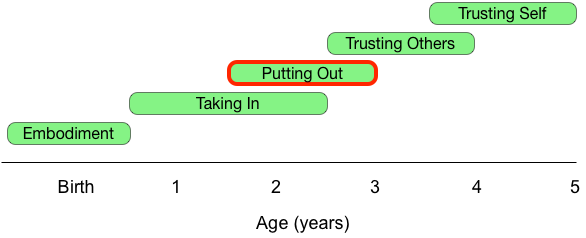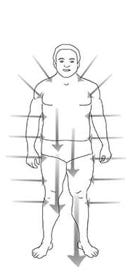[This is part of BFNow Self-Study Module 3: Child Development and Adult Character. For more about the overall Self-Study program, please look at About BFNow Self-Study and BFNow Self-Study Orientation.]
If you haven’t done so already, let me encourage you to pause, relax and release, perhaps with a big stretch or three deep breaths.
The ultimate goal of this lesson is to support you in growing into your own creative, expressive capacity. Our pathway to that goal involves
getting an overview of the Putting Out developmental task and the defensive patterns that emerge when that task gets distorted or blocked
getting a start on healing any underlying wounds.
We will build on this material for the rest of this module and in Modules 4 and 5.
Timeframe
1.5 to 3 years
Developmental Task
To develop autonomy and a separate self. To develop one’s own will and one’s own sense of needs and to take action to meet those needs. To have and express one’s own opinions and choices. Requires caregivers who can expand the child’s sphere of autonomy at a pace that allows for healthy development.
When it’s completed well, the child learns that it’s OK to have a separate self, to have a will and to act based on that will. Life continues to feel safe and worth living. But if the task gets blocked or distorted, the child becomes conflicted and immobilized.
Adverse Circumstances and Initial Triggers
This is the time of the “terrible twos” when children discover “no” and begin to exert an independent will. Caregivers who have difficulty with this (and what parent hasn’t found it to be a challenging time!) may enter into a profound power struggle with the child. Indeed, until the post World War II era, parents were advised and expected to break the will of children and force them into obedience. This was an important way in which Empire Era cultures maintained themselves. Even now, the main way political scientists measure authoritarian attitudes is with questions about child-rearing practices.
Parents who attempt to suppress the budding will and individuation of the child through physical or emotional force put the child into an intense inner conflict between 1) his/her need for the parent’s support and the child’s own need for safety and 2) the child’s need for self-respect and a functioning will.
Such parental behavior can be chronic or it can be occasional, such as when an otherwise tolerant parent gets overwhelmed or exhausted. If it happens only occasionally, the seed may be planted for a sub-personality that carries this trauma even if it doesn’t affect most of the territory of the child’s personality. I’ve described the triggers in strong terms but even milder forms can have an effect, especially if the child is sensitive to begin with.
Defensive Patterns
Children can fight long and hard for their autonomy, but determined parents have the upper hand, especially in authoritarian settings. If the parent “wins” this battle, the child eventually stops fighting and becomes outwardly compliant and buries his/her will and sense-of-self deep inside. To the extent there is still some will visible, it is a will to resist, to say “no,” to become immobile. There is a self-negation that internalizes the oppressor, a resentment at the oppression and a shame for giving in.
Following Kessler, I’ll call this a Enduring defense pattern.
Indicators
How can you tell if one of your sub-personalities has an Enduring defense pattern? Here are some clues. They don’t need to all match or be as stark as I’m describing them. In an Enduring sub-personality:
you don’t know what you want, only that you don’t want what’s been suggested
you seek someone to provide you with direction but resist at the same time
you are likely to feel heavy, stuck, defeated, invaded, easily humiliated
you avoid self-expression, action, success – anything that will bring you attention
you will self-sabotage if need be to avoid attention
under stress you are likely to go inward, become immobile, not act, resist
you are likely to believe: I can’t win; Life is hard; I just have to endure, You can’t make me
you hold in, your inner critic attacks you with guilt and you create what sense of safety you can by retreating inward and resisting
you take a long time to speak your thoughts, as if you have to pull them from deep inside
you feel that time has stopped, at least for you
Positive Aspects
Not all is grim. The defensive pattern itself requires or encourages certain skills and abilities and these can continue to make a positive contribution even after healing the original wounds.
Enduring types gain a deeply grounded strength. They become masters of personal space, sensitive to when it is being respected or not, and can hold space for others. Once healed of their own wounds, they can show great patience, tolerance and acceptance. They can be great diplomats and mediators. They have great stamina and can carry on for a long time without recognition. Once healed, they have a strong sense of who they are with a deep keel in the storms of life. Kessler identifies Eeyore and Charlie Brown as examples of the Enduring character style.
Energy Flow
People in the Enduring pattern give a sense of being hunkered down, tending to pull their energy in and send it down to the lower half of their body and to the ground.
The classic Enduring body type tends to be muscular and compact, slightly slumped with a sense of holding rather than motion – strong like a rock.
When the Enduring pattern isn’t predominant but just in a particular sub-personality, the body won’t be the Enduring type, but the sense of compactness and holding-in may well show when the Enduring sub-personality is active.
Alternate Names
The classic name for this character style is Masochistic. Johnson calls it the Defeated Child.
Relationship to Attachment and Pursuit/Withdrawal
While the correspondence is not exact, the Enduring character style connects best to the anxious-avoidant attachment style. Here is what we have so far:
In couples, or in any close ongoing dyad, the two partners will often develop a pattern where, under stress, one tends to pursue while the other tends to withdraw. A sub-personality with a Enduring character style would tend toward withdrawal when stressed. Here is what we have so far:
Healing Strategies
As with all of the defense patterns, the key is to build up corrective experiences that give you the skills you missed in childhood and allow you to replace the beliefs that now hold the pattern in place.
With the Enduring pattern, the goal is to uncover your sense of self and feel safe to express your own identity.
Just as with a Chinese Finger Puzzle, you often need to move in the opposite direction from your habitual impulse.
Here are some examples for the Enduring pattern:
Adopt a private fun creative practice and allow yourself to play. Don’t let anyone judge what you do, including your inner critic. The results don’t matter – you are strengthening your capacity to make your own choices and act.
Move your body. Walking is good and so is dancing. Be however private you need to be to feel safe and able to express yourself. This will help your body to change from the stuck pattern it has been in.
Claim your space. Find a private space and practice claiming it. Move around in it. Expand your energy out from your body. Speak (even shout) your claim of the space.
Experiential
I’m going to recommend two parts to today’s experiential, similar to what we’ve done so far. If anything in this experiential triggers you or feels overwhelming, just stop and get support from people you know.
The first part is about awareness. Starting now and throughout your day, tune into whether you have any sub-personalities with a Enduring character style. Make notes in your journal about what you find. While it may be easier to see some of these character styles in other people, best to understand them in yourself first.Make a rough estimate of the proportion of time you spend in this character style (as a first step toward a pie chart at the end of the module). You can, and likely will, adjust this estimate as the module goes on.
The second part is about healing. In the evening, get into your Optimal Zone adult sub-personality (a few deep breaths can help) and from there connect to one of your Enduring pattern sub-personalities. If you don’t feel you have one (which is entirely possible), still read over the rest of this experiential and imagine, briefly, how you might do it if you did have one.Take some first steps toward developing a partnership in which the Optimal Zone adult can help the younger sub-personality complete the original Putting Out developmental task. This help, over time, will likely involve:
• keeping your energy well contained and carefully respecting the younger sub-personality’s need for space, to not feel over-powered
• reassuring the younger sub-personality that they are no longer under attack; you are here now to guard the space while they moves forward
• asking the younger sub-personality what they need and listening empathetically
• validating that they did the best they could with the resources and skills available at the time
• helping the younger sub-personality shift beliefs toward a positive sense of self and the legitimacy of his/her own preferences and will.
• building skills and having corrective experiences that bring them comfortably and pleasurably into their own capacity for self-expression and action.For now, just spend some time, in the spirit of the Inner Smile, connecting with the defeated child at the core of your Enduring style sub-personality. Let it know, as you would with a child, that you are there with respect and support. Listen to what they have to tell you. For now, just be gently with them.
You can take this further if you have the inspiration for what to do – or you can just let this experiential be a seed well-planted for future healing. If you want to really go into this, I recommend at least getting either Schuitemaker’s or Kessler’s book as a guide.
Thanks,
Robert
[Link back to the Module 3: Child Development and Adult Character Overview page.]






